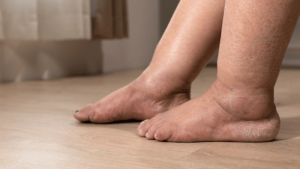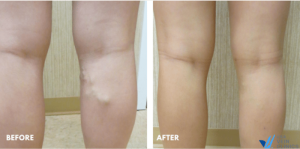
Could it be a circulation problem? Is it a sign of something serious? Will it go away on its own?
In general, you shouldn’t ignore leg swelling, whether it’s one leg or both. Swelling is usually a sign of an underlying health problem.
While swelling in both legs can be bothersome, experiencing swelling in just one leg is a cause for concern. It often indicates a sign of a more serious underlying issue, such as a blood clot (deep vein thrombosis, DVT)) or an infection. If you notice swelling in only one leg, it’s important to understand the causes and seek medical attention promptly.
Read on to learn the possible causes, vein treatment options, and when to seek emergency medical attention.
Join Our Newsletter for Health Tips
What Is Unilateral Leg Swelling?
Unilateral leg swelling simply means one leg becomes swollen while the other looks normal. The swelling might also be in the feet or ankles.
Leg swelling occurs when fluid gets trapped in the leg tissues. It’s also called edema, a term used to describe swelling caused by excess fluid accumulation.
There are different reasons why you might notice one swollen leg. It could be minor, like a soft tissue injury that will heal in a few days. Or there might be a chronic health issue that requires medical care, like chronic venous insufficiency or lymphedema. It can also be a warning sign of a medical emergency, such as a blood clot. a weakening in the artery, or an infection.
Knowing the causes and their associated symptoms can help you decide what to do if you notice one of your legs is swollen.
Common Causes of Swelling in One Leg
One-legged swelling, where only one leg experiences puffiness or fluid buildup, can cause concern. Here, we explore some of common causes of leg swelling, categorized based on their severity to help you understand this symptom better.
Non-Serious Causes of Leg Swelling
Prolonged sitting or standing
Being sedentary can cause fluid to pool in the legs, leading to temporary swelling. For example, if you sit at a desk for four or more hours a day, changes in blood flow occur, causing fluid to accumulate.
Minor Injury or Infection
If you notice sudden, localized swelling in one leg, it could be caused by an infection or injury, such as sprains, strains, or insect bites. If this is the cause of your symptoms, you might also notice redness around the swelling or warm skin to the touch.
Menstrual Cycle
Some women experience swelling and discomfort in the local limbs as part of their menstrual cycle. This happens because hormonal fluctuations can lead to temporary fluid retention.
Causes of Leg Swelling That Require Attention
If you notice signs of the following causes of leg swelling, or if your symptoms are persistent, it’s important to see a doctor:
Varicose Veins
Varicose veins are weakened veins that become enlarged. They can lead to swelling, achiness, and a feeling of heaviness in the legs.
Lymphedema
Damage to the lymphatic system can also cause leg swelling. Lymphedema is usually caused by surgery, radiation, trauma, or a tumor.
Lymphedema will cause chronic edema. If lymphedema is causing your leg to swell, you might also notice a feeling of heaviness or tightness, hardening of the skin, and limited range of motion.
Chronic Venous Insufficiency
Vein disease, or chronic venous insufficiency, is common in older adults. It’s caused by vein damage — the valves malfunction, causing blood to pool in the lower extremities, leading to fluid retention.
Chronic venous insufficiency is a progressive condition that worsens with time. It might start with varicose veins. You might notice leg pain, edema, rashes, and venous ulcers as it progresses. In severe cases, patients also develop secondary lymphedema.
If you have chronic leg swelling in one or both legs, it’s important to see a vein specialist for a diagnosis and treatment.
Serious Causes of Leg Swelling
The following are serious conditions that require medical attention right away:
Deep Vein Thrombosis (DVT)
DVT (Deep Vein Thrombosis) occurs when a blood clot in a deep vein in your leg partially or completely blocks blood flow. The clot might divert blood circulation to other veins, causing swelling and pain.
If the clot breaks free, it can travel to the lungs. A clot in a blood vessel in the lungs is called a pulmonary embolism. These clots can be extremely dangerous because, if they stop blood from reaching the lungs, they can cause lung damage.
Cellulitis
Cellulitis is a severe bacterial skin infection. It causes rapid swelling and pain. The affected area might also be tender to the touch. This type of infection can be life-threatening.
Popliteal Artery Aneurysm
Severe pain and a bulge behind the knee (where the popliteal artery is located) are signs of a popliteal artery aneurysm. If it bursts, it can cause uncontrolled bleeding.
Pitting Edema vs. Non-Pitting Unilateral Leg Swelling
One-legged swelling can be categorized into two main types: pitting edema and non-pitting edema. Each type has slightly different symptoms, which can help doctors diagnose the underlying cause.
Pitting edema in the leg, ankle, or foot occurs when the excess fluid is mostly water. With this type of swelling, if you push on your leg with your finger, you’ll make an indentation or ‘pit.’
Pitting edema is generally caused by chronic venous insufficiency and poor circulation caused by a sedentary lifestyle. Blood pools in the lower extremities, leading to fluid build-up.
If you notice signs of pitting edema, a vein specialist can sometimes play a crucial role in treatment. Pitting edema can be a symptom of underlying venous insufficiency, where veins struggle to return blood to the heart. Vein specialists are experts in diagnosing and treating various vein conditions, including those contributing to edema.
With non-pitting edema, the extra fluid combines water and other substances—namely proteins and salts—so when you press on the skin, you won’t create depression.
If your main symptom is non-pitting edema, the underlying health condition causing the leg swelling is likely related to an issue with your thyroid or lymphatic system. Your primary care doctor is often the first point of contact. If there is a suspicion of a vascular issue causing the edema, a vein specialist can also be consulted. They can perform specialized tests like ultrasounds to evaluate blood flow.
Treatment Options for Leg Edema
Edema causes excess fluid to build up in your tissues often affects your feet, ankles, and legs. While anyone can experience it, pregnancy and being over 65 increases your risk.
Edema can often be managed through lifestyle modifications such as dietary adjustments and increased physical activity. Sometimes, your doctor might recommend a diuretic, also known as a “water pill,” to help your body eliminate the extra fluid.
Edema and Vein Disease
However, persistent leg swelling can sometimes indicate an underlying condition like vein disease. Chronic venous insufficiency (CVI), and varicose veins are two common causes. CVI weakens valves in the veins, leading to poor circulation and fluid buildup. Varicose veins are enlarged veins that can cause leg swelling, pain and discomfort.
Endovenous laser therapy (EVLT) is an effective option for treating edema and vein disease. During EVLT, a thin laser fiber is inserted into the diseased vein. The laser energy gently heats and closes the vein, rerouting blood flow to healthy veins and relieving leg swelling.
USA Vein Clinics: Helping You Get Back on Your Feet
At USA Vein Clinics, we specialize in minimally invasive vein treatments that address the root cause of leg swelling caused by vein disease. These treatments are designed to quickly get you back to your normal routine with minimum recovery time.
Click to Call and Schedule a Consultation
Here’s How We Can Help:
- Experienced Vein Specialists: Our vein doctors can examine your legs to determine what’s causing your swelling and recommend the most effective treatment.
- Minimally Invasive Procedures: We offer a variety of FDA-approved procedures, which are performed in our offices for maximum convenience.
- Comprehensive Care: Our doctors can also advise on treatments for other conditions, like DVT or lymphedema. Addressing vein disease can help prevent these complications from developing in the future.
If your swelling is caused by vein disease, we offer advanced minimally invasive procedures that can reduce the source of your swelling, reduce pain and improve circulation.
- Endovenous Laser Therapy (EVLT)
- ClariVein®
- VenaSeal™ Treatment
- Varithena Vein Treatment
- Radiofrequency Ablation (RFA)
- Visual Sclerotherapy
- Ultrasound-Guided Sclerotherapy
Our experienced vein specialists can help you get back on your feet by pinpointing the cause and recommending the most effective treatment.
Medically Reviewed By:
Dr. Yan Katsnelson is a philanthropist, business owner, and highly skilled cardiac surgeon. He is the Founder and CEO of USA Vein Clinics, which is part of USA Clinics Group, the parent company of USA Fibroid Centers, USA Vascular Centers, and USA Oncology Centers, with more than 100 facilities nationwide. Dr. Yan has established himself as a strong advocate for accessibility and affordability of the most advanced medical care close to home. His mission is to create a positive experience for each patient with compassionate, personalized, and expert care.









